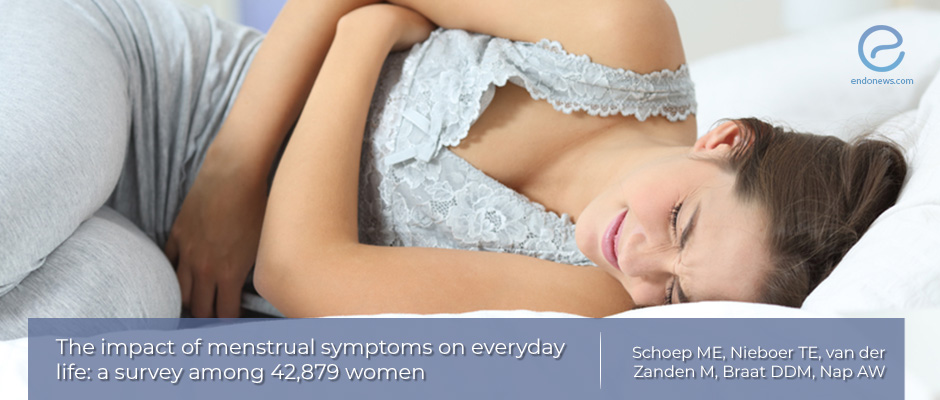Impact of Menstrual Symptoms on Everyday Life
Apr 10, 2019
It’s Time to Talk about Menstrual Symptoms Openly
Key Points
Highlight:
- Dr. Nap group from Netherlands evaluated the prevalence of menstrual symptoms and the impact of these symptoms on daily activities.
- This is the largest cross-sectional survey on the subject of menstrual symptoms in the general population.
Background:
- Menstrual symptoms, including heavy menstrual bleeding, dysmenorrhea, and significant perimenstrual mood disorders, are common gynecological conditions.
- Menstrual symptoms have a significant impact on quality of life and account for substantial healthcare use.
- Little is known about the prevalence of menstrual symptoms in the general non-selected population.
- There is a need to obtain a nationwide overview of menstrual symptoms and their impact on quality of life and everyday activities.
Key points:
- Nationwide, a cross-sectional, internet-based survey among 42,879 women aged 15 to 45 years, conducted.
- Dysmenorrhea was the most common, with a prevalence of 85%, followed by psychological complaints (77%), and tiredness (71%).
- During their menstrual period, 38% of all women were not able to perform all their regular daily activities.
- From the women that had to skip tasks due to their symptoms, only 48.6% told their family that menstrual symptoms were the main reason.
Conclusions:
- Dr. Nap group observed a high prevalence of menstrual symptoms in the general population, with dysmenorrhea, psychological complaints, and tiredness being the most distinct.
- Over one in three women reported that they perform fewer activities due to their menstrual symptoms.
- Further research is needed to develop appropriate interventions to address these problems.
Lay Summary
Menstrual symptoms, including heavy menstrual bleeding, dysmenorrhea, and significant perimenstrual mood disorders, are common gynecological conditions. About 30% of women consider their menstrual bleeding heavy, and 34–94% of women experience pain during their menstrual period.
Menstrual symptoms have a significant impact on quality of life and account for substantial healthcare use. Annual costs for patients with heavy menstrual bleeding are estimated to exceed $ 2000 per patient, mainly due to work absence and lost productivity. Currently, only little is known about the prevalence of menstrual symptoms in the general non-selected population. Therefore, Dr. Nap group from the Netherlands performed this study to obtain a nationwide overview of menstrual symptoms and their impact on quality of life and everyday activities.
In this cross-sectional online survey, 42,897 women aged 15 to 45 years have participated. This has been shown a high prevalence of menstrual symptoms with significant impact on daily activities. Dysmenorrhea was the most common, with a prevalence of 85%, followed by psychological complaints (77%), and tiredness (71%). During their menstrual period, 38% of all women were not able to perform all their regular daily activities. From the women that had to skip tasks due to their symptoms, only 48.6% told their family that menstrual symptoms were the reason for the transfer of tasks.
In conclusion, the authors observed a high prevalence of menstrual symptoms in the general population, with dysmenorrhea, psychological complaints, and tiredness being the most distinct. Over one in three women reported that they perform fewer activities due to their menstrual symptoms. This is the largest cross-sectional survey on the subject of menstrual symptoms in the general population, and they hope to have an impact on social perception towards women suffering from menstrual symptoms.
Research Source: https://www.ncbi.nlm.nih.gov/pubmed/30885768
Catamenial Dysmenorrhea General Population Menstruation Survey

